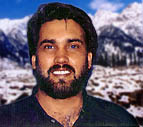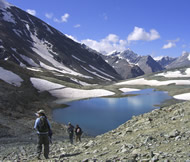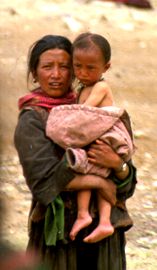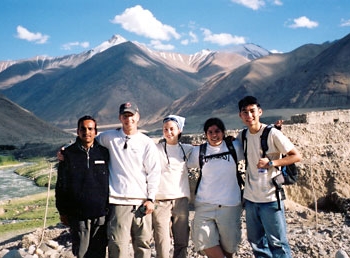by Shyla Nambiar; Published 2/8/2011; © 2011 Shyla Nambiar
India’s Himalayan country covers a rugged terrain dotted with stunning, snow-clad mountains, waterfalls, Buddhist monasteries, and Hindu temples. It is a fabled land conjuring images of Eastern mysticism and breathtaking winter scenery.
But villages here are often isolated from the rest of the world for seven months at a time by heavy snows and avalanches. Residents of these areas have no access to nearby healthcare and must walk long distances to get to a clinic.
The Start of the Journey

These circumstances propelled Ravi Singh, a native of the northern Indian state of Himachal Pradesh, to set up an organization, the Himalayan Health Exchange (HHE), to address the healthcare needs of the local population. The term “exchange” refers to the collaboration between physicians in India and the Western doctors who travel to the region. Initially started as a single medical visit to the area in 1996, the Decatur, Georgia-based group has grown from a team consisting of five volunteers to 250 people.

HHE focuses on providing medical care to needy people within a region spanning four states located in the Indian Himalayas. The group sponsors yearly trips for volunteers, most of who come from the United States but also includes Canadians, Britons, Australians, and New Zealanders. Mr. Singh accompanies them to India. HHE relies on no outside funding but rather generates donations from volunteers who pay for their own expenses and contribute to buying medical supplies.
Expeditions are conducted from February, after the worst of the winter weather, through the summer and typically last three to four weeks. HHE is invited to all of the areas it works in by the local government or the regional healthcare system. The teams usually consist of 35 members comprised of physicians, residents, and medical students from any field. They also include dentists, ophthalmologists, and nurses. HHE arranges the trips and accommodations in India and provides translators for the volunteers.
An HHE Mission

Dr. Guy Nuki, an emergency room physician from Waterville, Maine, has participated in seven or eight trips with HHE and has even brought along his wife, a nurse, and children. He found the organization on the Internet and became involved with sending family medicine residents to India, then made his first trip, replacing a physician who was unable to go. He ended up in Dharamsala, where the Dalai Lama resides.
Dr. Nuki worked in HHE’s various, onsite clinics and said that the doctors see everything in the villages, same as in the US. Tuberculosis and leprosy still exist in the region, though leprosy is diminishing. Rheumatic heart disease as well as abdominal and dermatologic problems, back pain, joint pain, pneumonia, and gum disease are some of the ailments doctors and dentists treat. They also see leishmaniasis, a skin disease spread by sandfly bites, common to developing countries, and vitamin deficiencies among children.

Clinic sites are set up in villages, and patients line up to be seen by doctors. It is not uncommon for a fews hundred patients to wait in line for a visit. Patients are registered and go through a triage system to have their blood pressure and temperatures checked. They then proceed to stations staffed by medical students, residents, or attending physicians and are given a diagnosis and a treatment plan. They then head to the pharmacy to receive medication. The services and medications are free for the patients. For patients whose conditions require more extensive treatment, HHE ensures that they receive care at a hospital in India and makes the arrangements.
Volunteer medical students not only gain experience dealing with patients but obtain a concurrent educational experience during the trips. Dr. Nuki developed a curriculum of lectures, readings, and evaluations designed to give the students an intensive education. Everyday, after working in the clinics, the students attend a one-hour lecture on relevant topics and case reviews and give talks themselves.
Patient Experiences
Local villagers are quite fascinated by seeing the volunteers from foreign countries, and patients themselves are grateful for the care they receive. Often, villagers will organize cultural events for the volunteers to thank them for their services.

The importance of delivering medical treatment to people who have little access to it is highlighted in some of Dr. Nuki’s recollections. At a clinic site, an intern once brought him an eight-year-old girl who was deaf but could speak. After checking her ears, Dr. Nuki found that one of her ears was damaged, but the other ear was clogged with something big and black. A trip to an ear, nose, and throat specialist would have taken three or four days, but the intern managed to extract the mass from the child’s ear. The little girl could then hear again. Dirt and wax had accumulated in her ear to the point that she was deaf. Dr. Nuki stated that, “simply removing that changed this girl’s life. She hadn’t gone to school because she was deaf, but had dirt and wax buildup in her ear. It is often simple things like that that make a truly huge difference.”
On another occasion, while Dr. Nuki and other volunteers were working in a giant cement room in a building in Sikkim, another Indian state, he examined the X-ray of a little boy who had been hit by a car nine months before and had broken his femur. The child’s parents were advised not to let him walk, and he did not attend school. Neither he nor his parents were present at the time Dr. Nuki looked at his X-ray but, because of the distance from their home to the clinic, the father only arrived at the end of the day with his son on his back, when the team of volunteers was packing up to leave.
After taking a new X-ray, Dr. Nuki suspected the boy’s injury was a clinically cured fracture. He picked up the boy, put him down across the room, and asked him to walk to his father. After some encouragement, the boy walked across the room and his family began crying. Now the child is fine and able to return to school.
While these instances may not seem significant, they underline the long-term impact HHE has in the areas it serves. As Dr. Nuki explained, “Often people in small villages. . . how they improve their lives is to get their children educated and they leave, go to college, come back with new things.” Children’s education is vital to the welfare and future of these communities, and attendance at school is not disrupted by illness due to the care children receive from an organization like HHE.
What HHE Accomplishes

Another volunteer for HHE, Dr. William Alto, was recruited by Dr. Nuki. He also lives in Waterville and specializes in family medicine. Dr. Alto has worked as a consultant for the World Health Organization and has spent 12 years overseas in hospitals and healthcare systems. He has volunteered with HHE for three years and made three trips to India, working in Kashmir, Ladakh, Sikkim, and Dharamsala.
Dr. Alto said,, “HHE is a particularly good group because they go to the same place or a similar place nearly every year so they’re pretty sustainable, do follow-up, and don’t charge anything. I think they do a really good job.” An example of the response to HHE’s efforts was provided to Dr. Alto when he traveled to a Tibetan school in the mountains where the children sang “We Shall Overcome” in English to the volunteers. Three of the schoolchildren there had had open-heart surgery and had been cared for by previous HHE teams, who organized the surgery for them in this village. The group was responsible for arranging and paying for treatment and follow-up in hospitals farther away.
Taking advantage of the surroundings, the volunteers find time for recreation by trekking the high-altitude areas. According to Dr. Alto, the staff will also often walk from one clinic site to another because it’s more convenient. Some of the trips have involved a lot of trekking to reach remote villages.
HHE’s future plans include a permanently staffed clinic in the Himalayas to provide ongoing care. The group focuses on commitment to the health of people within a certain geographic area and returns every year to care for their medical needs. Their dedication helps improve the lives of villagers who would not otherwise thrive and ensures continuing well-being and stability in this fabled region.
Related Links
- Himalayan Health Exchange
- Angels in Medicine: Nyaya Health: Improving Healthcare in Western Nepal by Mary Lou Bernardo, PhD, MSN
About the Author
Shyla Nambiar is a freelance writer based in Atlanta, Georgia.
